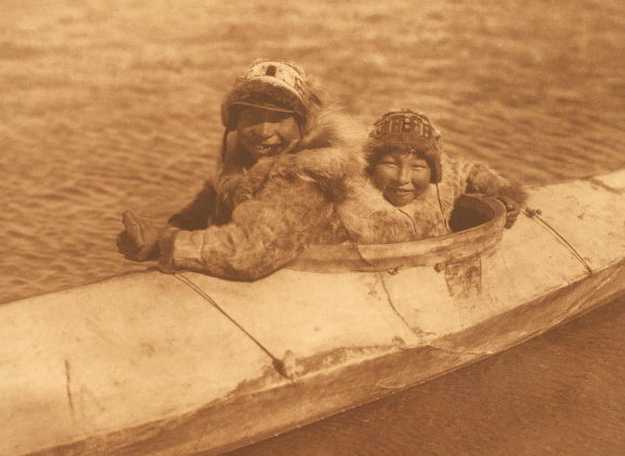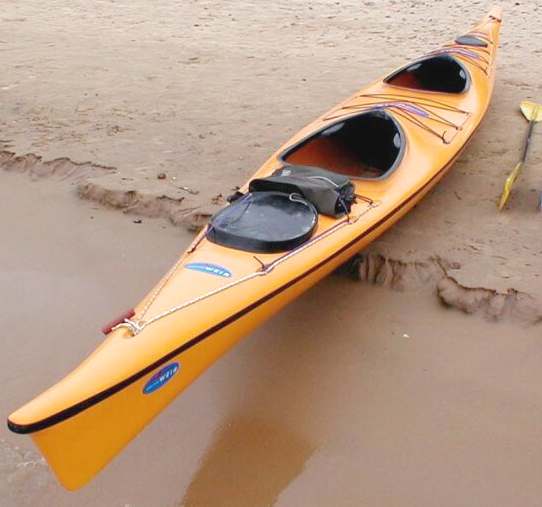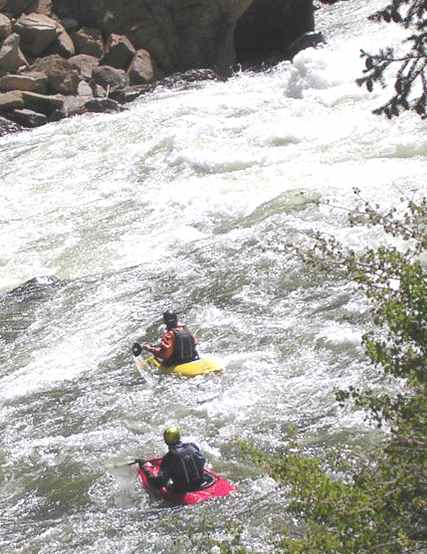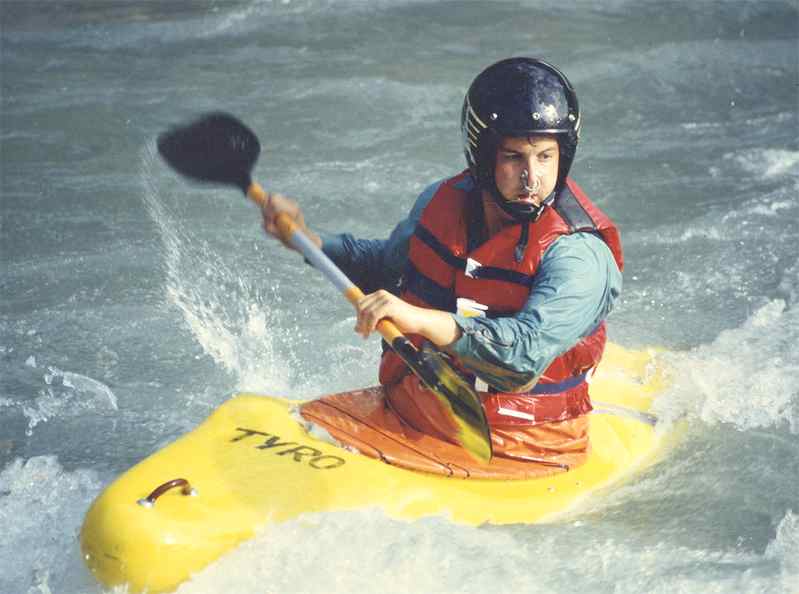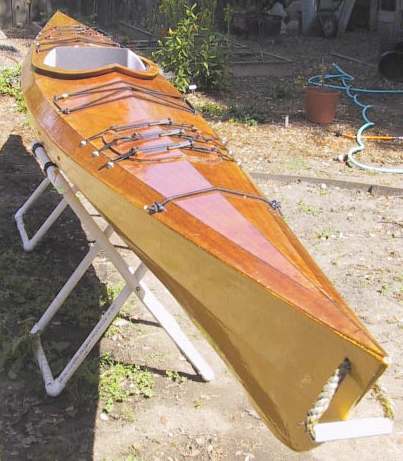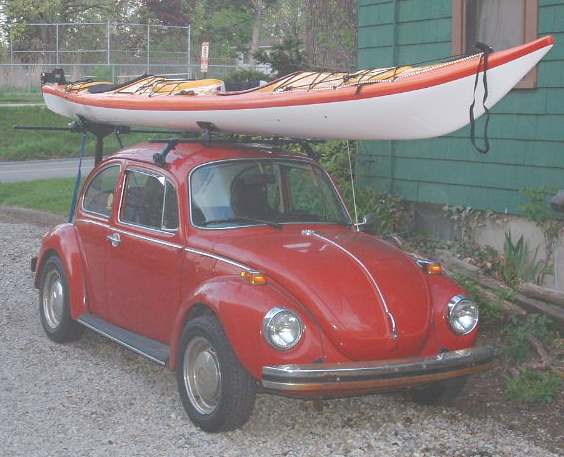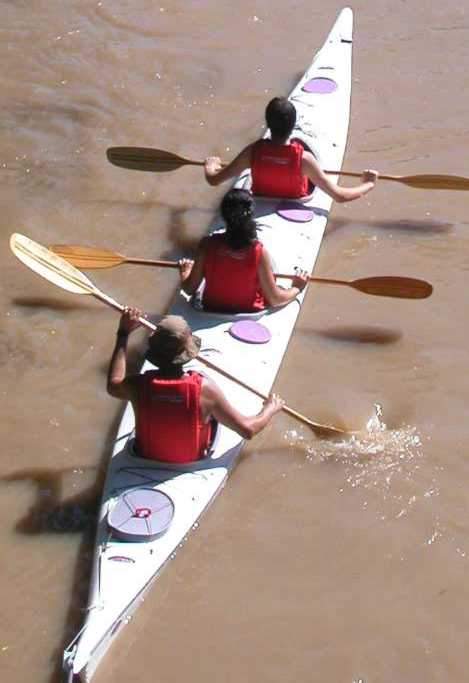|
KAYAK
|
| HOME | BIOLOGY | FILMS | GEOGRAPHY | HISTORY | INDEX | INVESTORS | MUSIC | NEWS | SOLAR BOATS | SPORT |
|
A kayak is a small human-powered boat. It typically has a covered deck, and a cockpit covered by a spray skirt. It is propelled by a double-bladed paddle. The kayak was originally developed by native Aleut and Inuit hunters in sub-arctic regions of North America and Greenland. Modern kayaks come in a wide variety of designs and materials for specialized purposes.
Kayaks may accommodate one, two, or occasionally three paddlers who sit facing forward in one or more cockpits below the deck of the boat. The spray skirt or similar waterproof garment attaches securely to the edges of the cockpit, preventing the entry of water from waves or spray, and making it possible in most styles of boat, to roll the kayak upright again without it filling with water or ejecting the paddler.
Kayaks differ distinctly in design and history from canoes, which are more flat-bottomed boats propelled by single-bladed paddles, although some modern canoes may be difficult for a non-expert to distinguish from a kayak. Kayaks are often called canoes in Great Britain and Ireland.
Boys in kayak, Nunivak, Alaska, by Edward S. Curtis, 1930
Origins
Kayaks were originally developed by the the Aleuts and Inuit indigenous peoples living in the Arctic regions of North America and Greenland, who used the boats to hunt on inland lakes, rivers and the coastal waters of the Arctic Ocean and the North Atlantic and North Pacific oceans. These first kayaks were constructed from stitched animal skins such as seal stretched over a wooden frame made from collected driftwood, as many of the areas of their construction were treeless. Archaeologists have found evidence indicating that kayaks are at least 4000 years old.
Though the term "kayak" is now used broadly for this class of boat, native people made many different types of boat for different purposes. The baidarka is double or triple kayak developed by indigenous cultures in Alaska and was used for hunting and transporting passengers or goods. An umiak ("women's boat) is a larger open decked boat ranging from 17 feet to 60 feet, made with seal skins and wood. It was paddled with single bladed paddles and typically had more than one paddler. It is thought the kayak originally started out as a decked over umiak and evolved into its traditional form.
The word "kayak" means "man's boat" or "hunter's boat", and native kayaks were a very personal craft, built by the man who would use them (with assistance from his wife, who would sew the skins) fitting his measures, for maximum maneuverability. The skin jacket of the hunter was then sewn into the skins of the kayak, to create a waterproof seal. The man would measure the frame for the kayak based on his forearm, and a typical kayak is about 19 feet (5.8 m) long. This measurement style confounded early European explorers who tried to duplicate the kayak because each kayak was a little different.
Because the user was sewn in, the boat was almost like a piece of clothing 'worn' by the boater. This meant that what is now known as a 'wet exit' (getting out of a kayak that has overturned, righting it, and getting back in) was impossible, leading to the importance of the eskimo roll maneuver, where the kayak is righted without leaving the cockpit.
Contemporary kayaks trace their origins primarily to the native boats of Alaska, northern Canada, and Southwest Greenland. Wooden kayaks and fabric kayaks on wooden frames (such as the Klepper) were common up until 1950s, when fiberglass boats were first introduced. Rotomolded plastic kayaks first appeared in 1973.
Modern two seat composite Kayak
Modern kayaks
Modern kayaks have evolved into numerous specialized types, that may be broadly categorized as sea kayaks, whitewater (or river) kayaks, surf kayaks, and racing kayaks, though many hybrid types exist as well. Sea kayaks are typically designed for travel by one or two paddlers on open water and trade manueverability for seaworthiness, stability, and cargo capacity. Sea-kayak sub-types include open-deck "sit-on-top" kayaks, recreational kayaks, and collapsible "skin-on-frame" boats. Whitewater kayaks are highly manueverable boats, usually for a single paddler, and include such specialized boats as playboats and slalom kayaks. Surf kayaks, often called "surf skis", are specialized narrow and long boats for surfing breaking waves and surf-zone rescues. Racing kayaks are designed for speed, and usually require substantial skill to achieve stability, due to extremely narrow hulls, though downriver racing kayaks are a hybrid style with whitewater boats.
Modern kayaks are made typically constructed from wood, fabrics over wooden or aluminum frames, plastic, fiberglass, kevlar, or carbon fiber. They come in one, two, and occasionally three person models.
Sea Kayaks
The sea kayak, though descended directly from traditional designs and types, is implemented in a wide variety of materials, and with many distinct design choices. Sea kayaks as a class are distinct from whitewater kayaks and other boats by typically having a longer waterline (emphasizing straight travel through the water over extreme maneuverability), and provisions for below-deck storage of cargo. Sea kayaks may also have rudders or skegs (also for enhanced straight-line tracking), and such features as upturned bow or stern profiles for wave shedding. Modern sea kayaks often have two or more internal bulkheads to provide watertight internal sections for flotation and waterproof storage. Sea kayaks, unlike most whitewater kayaks, may be built to accommodate two or sometimes three paddlers.
Strip Built Kayaks
Strip built kayaks are similar in shape to commercially available rigid fiberglass kayaks but much lighter. These hand built kayaks are both a work of art and a light weight durable craft. Like their fiberglass counterparts the shape and size of the strip built kayaks determine how they perform and what uses are optimal. The kayaks are built with thin strips of lightweight wood, often Cedar, Pine or Redwood. The strips glued together around a form, stapled or clamped in place, and allowed to dry. The boats strength comes from a layer of fiberglass cloth and resin, inside and out. Strip built kayaks are sold by a few companies for around $4,000 to $16,000. Anyone who is somewhat handy with tools could build one for about $400 in 200 hours. Cost and time will be determined by the builder's skill, materials chosen and design of the kayak.
Whitewater kayakers running the "Numbers" section of the Arkansas River
Skin on frame kayaks
Thought to have been developed by Siberian Yuit as a single man hunting craft. The frame of the kayak was usually of driftwood covered with seal skin . Most of the Inuit peoples from the Aleutian Island eastward to Greenland relied on the kayak for hunting ranging from whales to caribou though various types of seals were the most usual prey.
The Unangan or Aleut people are considered to have developed the native kayak to its highest degree. Their kayaks or "ikyaks" had a multi-chined, deep V, highly rockered hull. Ballast was commonly used to improve stability in the often stormy seas of the Aleutian islands. The two person kayak was also used by the Unangan.
The Greenland Inuit were well known kayakers due to their contact with early European explorers. The largely ice free waters of south-western Greenland led to highly skilled kayak men with the ability to use the kayak roll in case of capsize.
Today skin on frame kayaks are still being used for hunting by Inuit people in Greenland . In other parts of the world homebuilders are continuing the tradition of skin on frame kayaks albeit with modern skins of canvas or synthetic fabric.
Folding kayaks
A special type of skin-on-frame kayak is the folding kayak, the direct descendant of the original Inuit kayak. A folder is a modern kayak with a collapsible frame, of wood, aluminum or plastic, or a combination thereof, and a skin, of some sort of water-resistant and durable fabric. Many types have integral air sponsons inside the hull, increased secondary stability and making the kayaks virtually unsinkable.
Folders are known for their durability, stability, and longevity: The Klepper Aerius I, a single-seater, has been used successfully for white-water kayaking, due to its durability and excellent maneuverability, while many Kleppers have been in frequent use for more than 20 years.
Folding kayaks exhibit many of the same paddling characteristics as the original skin-and-frame vessels of the circumpolar north. Of all modern kayaks, they are closest relatives to the skin-and-frame boats of the past.
Sit-on-tops
Sealed-hull (unsinkable) craft were developed in the past for low level leisure use, as derivatives from surfboards (e.g. paddle or wave skis), or for surf conditions. Variants include planing surf craft, touring kayaks, and sea marathon kayaks. Increasingly, manufacturers are building leisure 'sit-on-top' variants of extreme sports craft, often with a skeg (fixed rudder) for directional stability. Sit-on-top kayaks come in single and double (two paddler) designs.
Serious whitewater kayaking
Recreational kayaks
Recreational kayaks are designed for the casual paddler interested in fishing, photography, or a peaceful paddle on a lake or flatwater stream; they presently make up the largest segment of kayak sales. Compared to other kayaks, recreational kayaks have a larger cockpit for easier entry and exit and a wider beam (27–30 inches) for more stability on the water; they are generally less than twelve feet in length and have limited cargo capacity. Using less expensive materials like polyethylene and including fewer options keep these boats inexpensive (US$300–$800). Most canoe/kayak clubs offer introductory instruction in recreational boats as a way to enter into the sport.
Whitewater kayaks
Whitewater kayaks are generally made out of rigid, high impact plastic, usually polyethylene. They are shorter than other types of kayaks, ranging from 6 to 10 feet (2 to 3 metres) long. The trend formerly was toward shorter boats, but this is now reversing slightly to longer boats of around 7 to 8 feet that can become airborne more easily. Whitewater kayaks are among the most maneuverable types made, however they are much slower than many other styles. Whitewater boats, however, do not need inherent speed. Their speed comes from their ability to ride the crest of flowing river. In "freestyle" competition ("kayak rodeo"), whitewater kayakers use features of rapids to do tricks, typically while remaining in one place on the river.
Ultra-low-volume kayaks that are designed to be paddled both on and below the surface of the water are used in Squirt Boating.
Surf kayaks
Surf Kayaking uses kayaks that are similar in design to whitewater kayaks, except they have a planing hull (flat side to side) to carve into a wave face, like a surfboard. While typically seven or eight feet in length, competition surf kayaks can be nearly twelve feet long to increase both planing speed while on a wave and to provide faster paddling speed for catching waves.
A variation on the closed cockpit surf kayak is an open cockpit design called a Waveski. Although the waveski utilises similar dynamics, in terms of paddling technique and surfing performance on the waves, construction can be very similar to surfboard designs. Elite waveski surfers are able to more closely imitate surfboard manouveres.
Racing kayaks
Flatwater racing kayaks
Flatwater racing kayaks are generally made out of very lightweight materials. They are not intended for anything other than flat water on a relatively calm day. They are thin, extremely unstable, and expensive, with a competitive K1 boat running in the $4000 range. They require a good level of expertise to paddle well, but are extremely fast in the hands of proficient users. The beam of a flatwater boat is typically barely wider than the hips of the person who paddles it, allowing for a very long and narrow shape to reduce drag. The most common types of flatwater racing kayaks (sometimes termed 'sprint boats') are K1 (single paddler), K2 (two paddlers) and K4 (four paddlers). These boats are raced at the Olympic level by both men over courses of 500m and 1000m and women, over courses 500m only.
Due to their long length (a one person sprint kayak is 17 ft (5.2m) long), sprint boats come equipped with a rudder to help with turning. The rudder is controlled by the feet of the paddler (the foremost paddler in multiperson designs). In spite of this, these boats still make fairly large turns.
Flatwater racing kayaks are closely related to flatwater racing canoes, and are usually paddled out of a common club or team, although it is rare for paddlers to compete in both canoes and kayaks.
A highly specialized variant of flatwater racing kayak called a Surf Ski has an open cockpit and can be twenty-one feet long but only eighteen inches wide, requiring expert balance and paddling skill. Surf Skis were originally created for surf and are still used in surf races in New Zealand, Australia, and South Africa. They have become very popular in the United States for both ocean races, lake races and even downriver races.
Kayak mahogany plywood kit nicely finished
Slalom kayak
Kayaks designed for Slalom canoeing have a hull for manouverability and—since the early 1970s—low profile decks. Specialty and multi-type kayaksInflatable kayaks
Another special type of kayak is the inflatable kayak. Inflatable kayaks usually can be transported by hand using a carry bag. They are made of hypalon (a kind of neoprene), pvc, or polyurethane coated cloth. They can be inflated with foot, hand or electric pumps. Multiple compartments in all but the least expensive increase safety. They generally use low pressure air, almost always below 3 psi.
Until recently, inflatable kayaks have been non-rigid boats, essentially pointed rafts, and best suited for use on rivers and calm water. However, recently some manufacturers have combined folding kayak design princicples (notably the use of an internal frame) with Sit-on-top kayak overall design using multiple inflatable sections to produce a seaworthy inflatable sea kayak.
Besides being portable, inflatable kayaks generally are stable and easy to master, but they take more effort to paddle and are slower than traditional kayaks. Pedal kayaks
A special type of kayak using pedals allows the kayaker to propel the vessel with underwater "flippers" attached to pedals int he cockpit, rather than a with a paddle. This allows the kayaker to keep his or her hands free for fishing or other activities, but introduces a somewhat delicate mechanical component into the boat. Modern kayak design
The design of different types of kayak is largely a matter of two dimensions of trade-off: between directional stability ("tracking") and maneuverability, the second between primary and secondary stability.
Length: As a general rule, a longer boat is faster while a shorter boat may be turned more quickly. A longer hull has less drag, i.e. it "cuts" through the water with less resistance. Longer boats may also have a higher maximum non-planing hull speed, but the effect is largely offset by increased friction, and only becomes significant at racing speeds. Kayaks that are built to cover longer distances such as touring and sea kayaks are themselves longer, generally between 15 and 18 feet. A flat water racing K1's maximum length governed by the ICF is 17 feet. Whitewater kayaks, which generally depend upon river current for their forward motion, are built quite short, to maximize maneuverability. These kayaks rarely exceed eight feet in length, and some specialized boats such as playboats may be only six feet long. The design of recreational kayaks is an attempt to compromise between tracking and maneuverability, while keeping costs reasonable; their length generally ranges from nine to fourteen feet.
Rocker: Length alone does not fully predict the maneuverability of a kayak: a second design element is rocker: the curvature of the kayak from bow to stern. A heavily "rockered" boat curves more than a boat with little or no rocker, meaning that the effective waterline of the rockered boat is less than for a kayak with no rocker. For example, imagine a hoop 30 inches in diameter. When set on its edge on a table, only a small portion of that hoop touches the table. Although kayak hulls are not so extremely curved as a hoop, it is analogous to what happens when a kayak with rocker is sitting in the water: although the overall length of the boat may be 18 feet, the length at waterline may only be 16 feet. Similarly, although a whitewater boat may only be a few feet shorter than many recreational kayaks, because the whitewater boat is heavily rockered its waterline is far shorter and its maneuverability far greater.
Hull form: Kayak hull designs are divided into categories based on the shape from bow to stern and on the shape of the hull in cross-section. Bow-to-stern shapes include:
The presence or absence of a V bottom at various points affects the kayak's tracking and maneuverability. A V tends to improve the kayak's ability to travel straight (track), but reduces the ease of turning. Most modern kayaks have V sections only at the bow and stern of the boat, and flatten or round out amidships.
Beam profile: Hull shapes are categorized by the roundness (or flatness) of the bottom, whether the bottom comes to a "V" at various points on the hull, and by the presence, absence, and severity of a chine, an angled join between two parts of the hull below the gunwales. This design choice determines the tradeoff between primary and secondary stability. The hull design is the primary contributor to the boats primary stability and secondary stability, the resistance of the boat to tipping and to ultimate capsize, respectively.
Primary and secondary stability: Although every kayak will rock from side-to-side, wider kayaks with more buoyancy away from the centerline will present more resistance to tipping and thus feel less likely to capsize than a narrow one with less buoyancy away from the centerline. Flat-bottomed boats that push their volume away from the centerline will also feel more stable than rounded or V-shaped hull shapes that distribute buoyancy more evenly.
While flat-bottomed boats have more primary (sometimes called "initial") stability, and feel more stable to the beginner they often have less secondary stability, and once they do begin to tip, they capsize quickly and suddenly. Round-bottomed boats reverse the situation, having lower primary stability and (usually) greater secondary stability. The chine in some boats increases secondary stability by effectively widening the beam of the boat when it is heeled (tipped).
Secondary stability refers to the ease of righting a kayak once it has been put off balance. Round-bottomed boats present a greater cross-section to the water as they are tipped from level ("heeled"), while very flat-bottomed boats present less. Boats that have lower primary stability will generally be easier to right when rolled too far. sea kayaks, designed for open water and rough conditions, are generally narrower (22-25 inches) and have more primary stability than recreational kayaks, which are wider (26-30+ inches), have a flatter hull shape, and more secondary stability. Until recently, whitewater kayaks had very rounded hulls, but changes in design philosophy have lead to whitewater kayaks with very flat planing hulls that allow them to sit on top of the water rather than in the water (displacement hull).
Cool VW Beetle and Kayak combo rig Trivia
The word "kayak" is a Palindrome - a word that is identical when spelled backwards.
KAYAK LINKS:
Solar Cola drinkers care about climate chaos ...
.. Thirst for Life
(330ml Earth can)
|
|
This
website
is Copyright
© 1999 & 2008 NJK. The bird |
|
AUTOMOTIVE | BLUEBIRD | ELECTRIC CARS | ELECTRIC CYCLES | SOLAR CARS |
